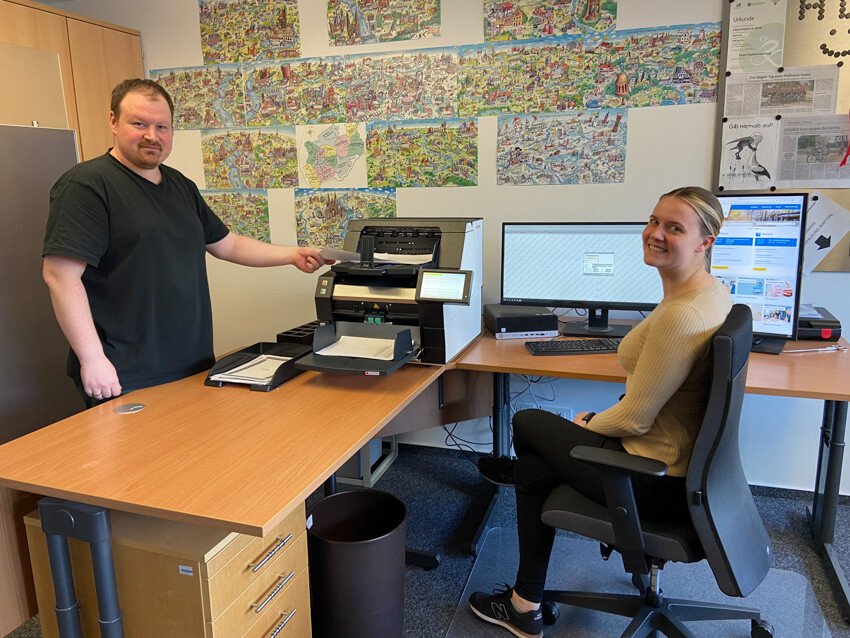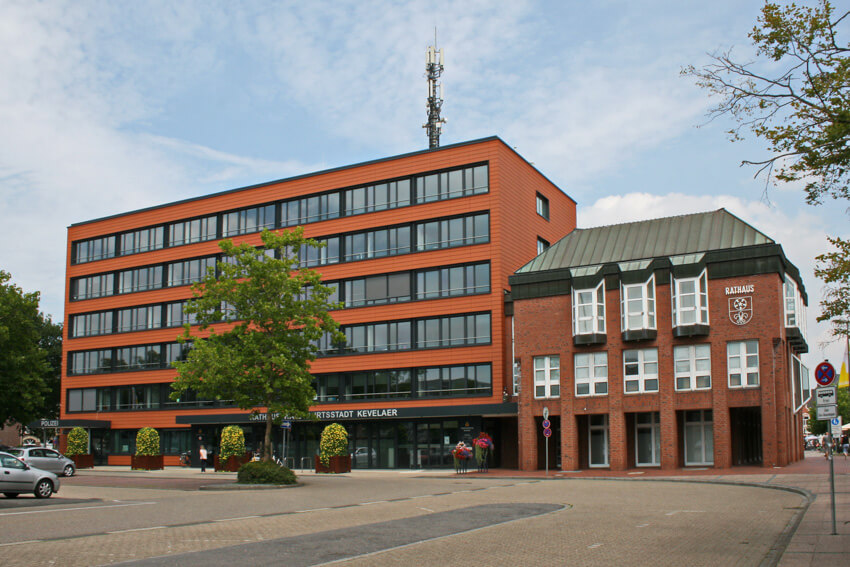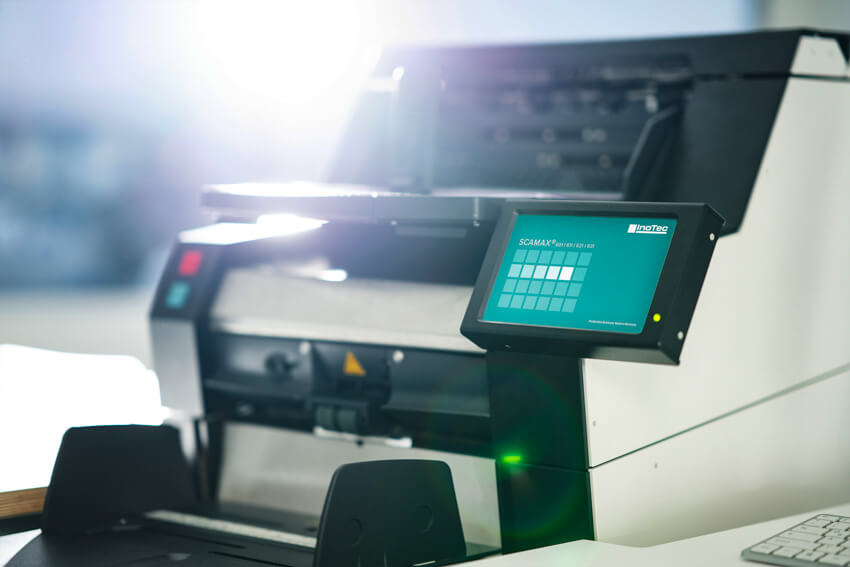Pilgrimage city of Kevelaer digitizes mailroom: with SCAMAX® 6×1 production scanner.
The pilgrimage city of Kevelaer in North Rhine-Westphalia has just under 30,000 inhabitants. Nevertheless, it has long since achieved supraregional fame. On the one hand, as one of the most important pilgrimage cities in Germany. On the other, through the advanced digitization of its facilities and authorities, driven forward by resourceful employees – mostly without a blueprint or binding instructions, but with all the more heart and initiative. There is a clear guideline from the mayor: What can be meaningfully digitized must be digitized. The latest result of this commitment: a professional digital mailroom, based on a genuine InoTec production scanner ‘Made in Germany’ – the SCAMAX® 6×1.

Christian Cleve, Anika Sestig, Central Services, Pilgrimage city of Kevelaer
The project at a glance
Customer: Pilgrimage city of Kevelaer
Project: Installation of a central scanning station / digitization of the mailroom
Scope: A SCAMAX® 601cd with SCAMAXscan+ and service package
Challenges: Most TR Resiscan-compliant processes possible for replacement scanning.
Project timeframe: 3 weeks from initial contact to test delivery; completed procurement process; 3 days from order to delivery

City hall of Kevelaer, © Bubo Bubo
The initial situation:
Decentralized scanning with a variety of different low-budget scanners
At the beginning of 2021, the city is still digitizing its documents in a decentralized manner. Various types of scanners will be used for this purpose at different locations: flatbed scanners, multifunction devices and floor copiers. But also low-priced document scanners from different manufacturers. The scanning processes differ greatly depending on the scanning place.
The problem:
Mass instead of class does not work
In many respects, the decentralized scanning approach with numerous low-budget devices does not meet the demands placed by those responsible in the Central Services department on the digitization of their incoming mail. Five points of criticism stand out in particular:
1. The availability: The low-budget devices fail again and again, requiring them to be sent in or completely replaced, which renders them unavailable for days and weeks. This makes it impossible to process certain concerns submitted by mail in a timely manner.
2. The image quality: The quality of the scans varies greatly, with some devices producing acceptable images, there is often little to be seen on other scans.
3. The process quality: The users of the respective scanners work conscientiously. However, the device-related differences in the work steps do not even rudimentarily allow a substitute scanning in the sense of TR-Resiscan.
4. The costs – both for the city and for the environment: Initially, the low-budget scanners are cheap to buy. However, as scanners have to be disposed of and purchased again and again, the cost per scan increases for the city, along with an escalating environmental impact.
5. The manufacturer service: The slightly more valuable feed scanners are theoretically repairable. In practice, however, it takes too long for qualified technicians to be available or even on site.
“After only a short period of decentralized scanning, we had already understood: To reliably achieve our goals, we need a genuine production scanner. Using many budget scanners instead of one professional device neither saves money nor leads to acceptable results in daily mail digitization. Especially not if you want to scan TR Resiscan compliant or close to it.”
Anika Sestig, Central Services, Pilgrimage city of Kevelaer
The requirements profil:
“Push the button, scan it, done.”
The project managers decide to install a central scanning station for mass digitization. In the future, only copy scanning is to be carried out in a decentralized manner. Also, the scanning of bound and particularly large-format material (DIN A0). A high-quality production scanner is to be purchased for the central scanning station. The requirements for the scanner are derived directly from the weaknesses of the previous, decentralized scanning solution with low-budget scanners:
1. the production scanner should be absolutely reliable, resistant to faults, and therefore highly available.
2. the production scanner should be easy and intuitive to operate. The same applies to the associated software.
3. the cooperation with the scanner manufacturer should be based on partnership: This includes, among other things, direct communication, fixed contact persons and fast on-site support. Wear or spare parts should be available in the shortest possible time.
4. the production scanner should be able to be cleaned by the employees themselves. Even basic work such as the replacement of wear parts should be carried out quickly, easily and without external technicians.
5. the production scanner should – as a major investment – be particularly durable: to ensure a low TCO; and to enable sustainable, environmentally friendly scanning.
“We wanted a particularly user-friendly, robust and uncomplicated scanner. After all, from the point of view of a comparatively small authority, that’s what ‘high performance’ means. Our main focus was not on the highest possible throughputs. But what we really wanted and urgently needed was a scanner that worked reliably and enabled the simplest of processes. Put it on, push the button, scan, done. No more. But by no means less either.”
Christian Cleve, Central Services, Pilgrimage city of Kevelaer
The scanner search:
“OK Google, show me the highest quality document scanners!”
At the beginning of the scanner search, the people in charge have no experience with premium scanners. Since the federal agencies offer neither orientation nor recommendations, the search begins on Google. In order to get to know the quality criteria of a production scanner and to build up competence in decision-making, Christian Cleve first searches for high-end devices. He ends up with the SCAMAX® series from InoTec – and asks himself what justifies the comparatively high purchase prices. He picks up the phone and asks the InoTec sales department a lot of questions. An hour later, he not only knows what features really matter when buying a production scanner and what the actual total cost of ownership of a scanner is. But also that the SCAMAX® 6×1 is the right lead product for the upcoming tender. A free on-site trial of a SCAMAX® 601cd is arranged.
The hardware solution:
The SCAMAX® 601cd
With the SCAMAX® 601cd, the pilgrimage city has opted for one of the most powerful and user-friendly desktop scanners in the world. The scanner is TR Resiscan-ready, scans in color and best image quality (according to ISO 19264-1, B). Its paper-friendly belt transport guides even difficult documents safely through the scanner, and the NoSCRATCH glass guides prevent device failures due to scratched rails. It is operated via an 18 cm color touch display with intuitive user interface and clear full-text messages.

The software solution:
SCAMAX® scan+
In order to optimize the user-friendliness of its scanning solution and achieve the best results, the pilgrimage city of Kevelaer opts for InoTec’s SCAMAX® scan+ scanning software. The multilingual program interface in Office design offers easy-to-understand icons and a freely definable quick function bar.
The presale phase and testing:
Security for the investment
To be on the safe side, to test the scanner extensively, and to experience its advantages live, the pilgrimage city of Kevelaer carries out an extensive test installation. There are no costs involved. Instead, the city gains valuable insights and the certainty of wanting to work with this or a comparable combination of scanner hardware and software in the future.
“As soon as the InoTec employees were on site and familiarizing us with the equipment, we realized that these people know and love their scanners. That gave us a good feeling. In daily scanning operation, what was promised to us in the presale phase was completely fulfilled: The scanner performs reliably, produces fantastic images and is super easy to use. If we had any questions, we got a specialist on the phone within minutes. After just a few days, we were already convinced that we wouldn’t want to do without this scanner.”
Anika Sestig, Central Services, Pilgrimage city of Kevelaer
The training and after-sales service:
1A service even after conclusion of the contract
Only a few days after the order, the permanent scanner is delivered and put into operation. InoTec conducts another training session for the future operators of the mailroom. In the weeks and months that follow, InoTec experts continue to be seen on site, providing valuable tips and support for special concerns and questions. In the meantime, the scanner is used for all municipal departments that are already connected to the document management system. Others will be connected successively.
Customer summary:
“A clear recommendation – also for neighboring municipalities.”
“We are more than satisfied with the scanner and the software. Our decision to go for quality is paying off: We are achieving our goals, digitizing on the same day, and have been able to take many processes to a new, digital level. The scanner is a real milestone on our way to a completely digital city administration. That’s why we have already presented and recommended it to neighboring municipalities.”
Christian Cleve, Central Services, Pilgrimage city of Kevelaer
About the Pilgrimage city of Kevelaer:
Kevelaer is one of the most important Marian pilgrimage cities and receives around a hundred thousand pilgrims and guests every year. In addition to the historic city center with its pilgrimage centers, the St. Jakob brine garden also attracts many people to the city. With the shell-shaped graduation house and the attractive park, the brine garden invites you to relax and take a deep breath.

Recent Comments